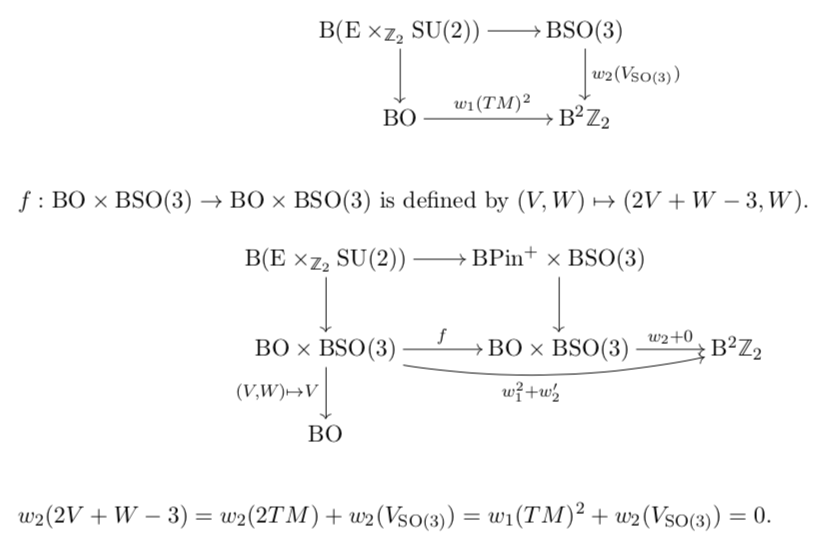Consider the extension
$$1\to SU(2)\to X\to O\to1,$$
there are 4 possibilities for $X$: $X=O\times SU(2)$ or $E\times_{\mathbb{Z}_2}SU(2)$ or $Pin^+\times_{\mathbb{Z}_2}SU(2)$ or $Pin^-\times_{\mathbb{Z}_2}SU(2)$ where $E$ is defined in Freed-Hopkins's work1 as the colimit of the group $E(d)$, the group $E(d)$ is defined to be the subgroup of $O(d)\times\mathbb{Z}_4$ consisting of the pairs $(A,j)$ such that $\det A=j^2$, where $\mathbb{Z}_4=\{\pm1,\pm\sqrt{-1}\}$ is the multiplicative group of order 4.
Here the notation $G_1\times_{\mathbb{Z}_2} G_2 :=\frac{G_1\times G_2}{\mathbb{Z}_2} $ is defined as mod out the common $\mathbb{Z}_2$ of $G_1\times G_2$.
The question is about computing $MT(E(d)\times_{\mathbb Z_2} SU(2))$ and the bordism group $\Omega_d^{E \times_{\mathbb Z_2}SU(2)}$.
(1) There is a short exact sequence of groups: $1\to SO(d)\to E(d)\to\mathbb{Z}_4\to 1$. So naively, people may suspect that $$MT(E(d)\times_{\mathbb Z_2} SU(2))=MT E(d)\wedge\Sigma^{-3}M SO(3)=MSO(d)\wedge\Sigma^{-2}M\mathbb Z_4\wedge\Sigma^{-3}M SO(3).$$ However, this is likely to be incorrect.
(2) The space $B(E \times_{\mathbb Z_2}SU(2))$ sits in a homotopy pullback square: a map $M \to B(E \times_{\mathbb Z_2}SU(2))$ is determined by two maps $M \to BO$ and $M\to BSO(3)$ which correspond to bundles $TM$ and $V_{SO(3)}$ such that $w_1(TM)^2=w_2(V_{SO(3)})$.
To compute the bordism group $\Omega_d^{E \times_{\mathbb Z_2}SU(2)}$, we need to know the Madsen-Tillmann spectrum $MT(E \times_{\mathbb Z_2}SU(2))$ and decompose it as the wedge sum or smash product of some familiar spectra.
The figure attachment here is my own attempt,
but the map $f$ is not a homotopy equivalence. I actually obtain an identification $$ \text{Thom$(B(E \times_{\mathbb Z_2}SU(2)),-2V)=MT(Pin^+ \times_{\mathbb Z_2}SU(2))$} $$ which is already known in 1604.06527 paper, but we need to know $$ \text{Thom$(B(E \times_{\mathbb Z_2}SU(2)),-V)=MT(E \times_{\mathbb Z_2}SU(2))$,}$$
where $V$ is the induced virtual bundle of dimension 0 by $B(E \times_{\mathbb Z_2}SU(2)) \to BO$.
- Is Thom$(B(E \times_{\mathbb Z_2}SU(2)),-2V)$=smash product of Thom$(B(E \times_{\mathbb Z_2}SU(2)),-V)$ and Thom$(B(E \times_{\mathbb Z_2}SU(2)),-V)$? If so, how to obtain Thom$(B(E \times_{\mathbb Z_2}SU(2)),-V)$ as the "square root" of Thom$(B(E \times_{\mathbb Z_2}SU(2)),-2V)$?
1 Reflection positivity and invertible topological phases Daniel S. Freed, Michael J. Hopkins, arXiv:1604.06527

